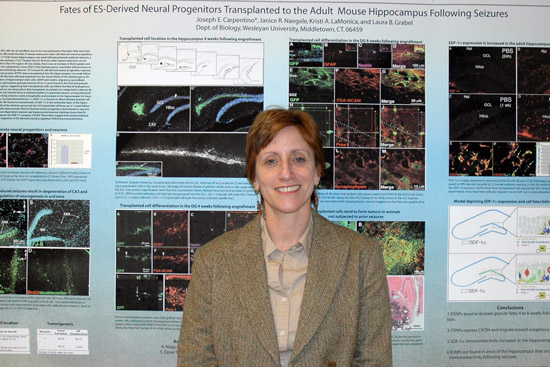Professor Awarded Grant, Will Co-Direct State Stem Cell Facility
 |
| Laura Grabel, the Fisk Professor of Natural Sciences and professor of biology, received $878,348 for her study on embryonic stem cells. |
| Posted 12/04/06 |
| Wesleyan and one of its researchers were major beneficiaries of the State of Connecticuts initial round of nearly $20 million in grants to fund non-federally-sanctioned stem cell research.
The awarding of the grants was announced on November 22 in Hartford. Wesleyan was a co-recipient with the University of Connecticut of $2.5 million dedicated for the Human Embryonic Stem Cell Core Facility, which will be located in Farmington. Laura Grabel, the Fisk Professor of Natural Sciences and professor of biology, also received $878,348 for her study titled Directing Production and Functional Integration of Embryonic Stem Cell-Derived Neural Stem Cells. Grabel will also be co-director of the Human Embryonic Stem Cell Core Facility with Ren-He Xu, associate professor and director of the human embryonic stem cell laboratory at the University of Connecticut Health Center. The Human Embryonic Stem Cell Core Facility will be a world class facility that will be a tremendous benefit to the states residents as well as our faculty and students, Grabel says. It lets us maximize the available resources and gives researchers a dedicated space to work with the unapproved stem cell lines. The stipulation regarding unapproved stem cell lines is extremely important to stem cell researchers because of the federal guidelines. It is not illegal to work with these non-approved stem cell lines; in fact, researchers in private industry have been doing so for several years. However, researchers cannot use facilities or resources that have been paid for by federal funds for approved stem cell lines in conjunction with research on non-approved lines. Most of the researchers involved have received federal funding for their work on approved stem cell lines, says Grabel, who has received NIH funding for her work with these lines. To partition a lab and replicate much of the materials and resources that are dedicated to federally-funded work would be tremendously wasteful and extremely impractical. This facility will eliminate any chance of overlap. A similar facility will also be created at Yale with an identical $2.5 million state grant. Grabel adds that use of these facilities will not be limited to the three universities who are being funded by the states stem cell initiative Wesleyan, Yale and UConn. Students from all the universities and colleges in the state will have the opportunity to be trained there, she says. Thats another great advantage of this facility. Well be training a whole new generation of stem cell researchers. Grabels work at the facility will be based on the individual grant she received from the state. Her research focuses on how to improve the effect of stem cells can be implanted in the brain to replace damaged neurons. When Grabel says we she is referring to her co-investigators, Janice Naegele, chair and professor of biology, professor of neuroscience, and Gloster Aaron, assistant professor of biology. We have some fantastic researchers here, and our capabilities and interests complement each other quite well, Grabel says. Its really the strength of our research abilities that the state responded to by making us a partner in this initiative. Parts of the Human Embryonic Stem Cell Core Facility in Farmington are already up and running. The rest should be fully operational in early 2007. |
| By David Pesci, director of Media Relations. |

